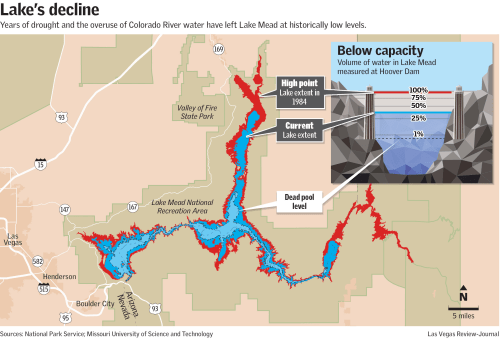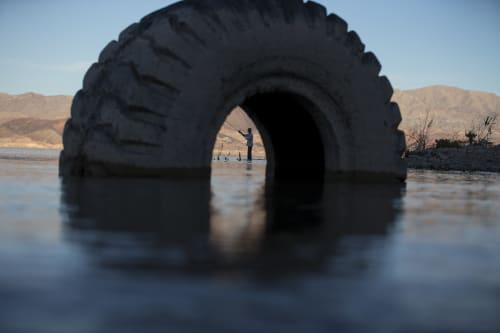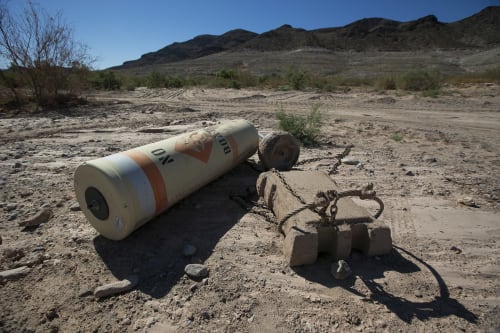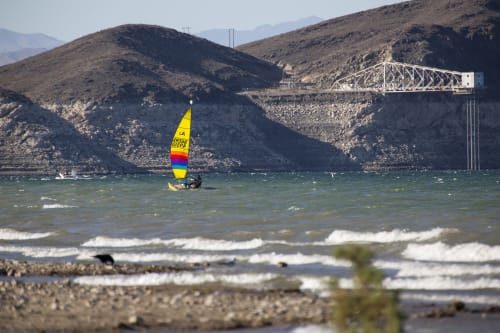fter more than three years of talks and repeated threats of federal intervention, water officials in seven Western states still haven’t quite finished an emergency drought plan for the Colorado River.
The so-called Drought Contingency Plan won’t be considered done until water users in Arizona and California sign off on all of the underlying agreements necessary to make the larger deal work, said Terry Fulp, Lower Colorado regional director for the Bureau of Reclamation.
As of Friday, Fulp said, there were still about 20 agreements waiting to be finished in Arizona and some lingering issues between California’s two largest Colorado River water users, the Imperial Irrigation District and the Metropolitan Water District of Southern California.
“These are being worked on feverishly, and we are hopeful these things can be done in the next few weeks,” he said. “We are just so close. We are going to get there I think.”

(Las-Vegas Review Journal)
The bureau has promised to step in with its own drought response if the states can’t complete their plan in time to execute it in August. Reclamation Commissioner Brenda Burman initially gave the states until Jan. 31. When that deadline came and went, Burman set a new one: By March 19, she wants the states to submit any final input they might have before her agency takes action on its own to address the river crisis.
The as-yet-unfinished drought plan calls for Nevada, Arizona and, eventually, California to voluntarily reduce their use of the river and leave more water in Lake Mead. Meanwhile, Colorado, New Mexico, Utah and Wyoming would send more water downstream to prop up Lake Powell and protect hydropower generation at Glen Canyon Dam.
Fulp said federal officials would rather not step in if they don’t have to, but time is running short.
For one thing, Mexico has agreed to share in the emergency drought cuts on the river, but only if the plan among the states is finalized. Fulp said it could take as much as 100 days to complete all the bureaucratic work needed to trigger Mexico’s participation, so “the time is now” to finish the interstate deal so the drought response can be implemented in August, when the bureau issues its river operations plan for the coming year.
Will it be enough?
Already, though, experts are debating whether the plan will do enough to keep the river’s two largest reservoirs from crashing.
Former Arizona Gov. and U.S. Interior Secretary Bruce Babbitt called the drought plan “an interim solution” and urged water users to immediately begin discussing a more difficult, long-term fix for the overtaxed river, one that’s likely to mean permanent reductions for at least some water users.
Former Southern Nevada Water Authority chief Pat Mulroy compared the drought contingency plan to a Band-Aid — something that will cover up a wound but won’t necessarily make it better.
“DCP has to happen,” said Mulroy. “But it’s a tourniquet. It is not going to solve the problem.”
She said it’s time for the river states to set aside self-interest and start sharing the water in a way that helps everyone without creating winners and losers.
“We’ve got to stop thinking about this in pieces. The very same mindset that made us finally realize that Southern Nevada needed (the Southern Nevada Water Authority) has to translate into the larger Colorado River community,” Mulroy said. “This isn’t about sound bites. This isn’t about placating your constituents. It’s about getting beyond that and looking at the entirety of the system.”
Current water authority General Manager John Entsminger agrees about the need for collaboration, but he doesn’t care for Mulroy’s analogy.
“I think it’s a lot more than a Band-Aid,” he said. “The Drought Contingency Plan is the next step in the evolution of how the seven states and Mexico operate this river system and ensure that we have the steps in place to keep the system from crashing. If we can maintain that level of interstate and international cooperation and maintain the political will that it has taken over the last 20 years to make these things happen, then we’re going to be OK.”
‘How vulnerable am I?’
But what if the drought has only just begun?
UNLV physics and astronomy professor George Rhee said it’s plausible that the nearly 20-year dry spell on the Colorado River could drag on for an additional 30 years.

Ivan Lau of Las Vegas is seen through a partially submerged tire as he fishes near Boulder Harbor at Lake Mead National Recreation Area in September 2018. (Richard Brian/Las Vegas Review-Journal)
A statistical analysis he published last year in the Journal of Climate with fellow UNLV researchers Jimmy Salazaar and Corwin Grigg ends with this startling statement: “We conclude with an 80 percent probability that the current drought will continue long enough into the future to deplete all existing water storages for the Colorado River system.”
Responding to something like that, Rhee said, requires a far more aggressive emergency plan than the one being debated by the river states.
“The real question we should be asking is, How vulnerable am I to what’s happening?”
Rhee also worries that, because of rising temperatures and flaws in past calculations, water managers might be significantly underestimating how much water evaporates from Lake Mead every year. As a result, he said, “the fix of the Drought Contingency Plan merely compensates for incorrect accounting rather than the root cause of the problem, which is climate change.”
Colorado State University climate scientist Brad Udall said his research suggests the river could see its flow decline by as much as 55 percent by the year 2100.
He called the drought plan a good first step toward coming to grips with the Colorado’s alarming new reality.
“The DCP needs to lead to a CCP — a climate change plan,” Udall said. “We need some painful but all-reaching solution.”
Contact Henry Brean at hbrean@reviewjournal.com or 702-383-0350. Follow @RefriedBrean on Twitter.

A buoy is seen high and dry near the defunct Echo Bay Marina at Lake Mead National Recreation Area on in September 2018. (Richard Brian/Las Vegas Review-Journal)
The cuts in question
The Drought Contingency Plan for the Lower Colorado River Basin calls for the following voluntary cuts based on the water level in Lake Mead, which sits at about 1,088 feet above sea level this the projected level on March 1:
Jan. 1 lake level between 1,090 and 1,045 feet:
■ Nevada: 8,000 acre-feet
■ Arizona: 192,000
Between 1,045 and 1,040 feet:
■ Nevada: 10,000
■ Arizona: 240,000
■ California: 200,000
At or below 1,040 feet:
■ Nevada: 10,000
■ Arizona: 240,000
■ California: Starts at 250,000 and increases by 50,000 for each additional 5-foot drop in the lake.
One acre-foot of water will supply two average Las Vegas Valley homes for just over one year.



